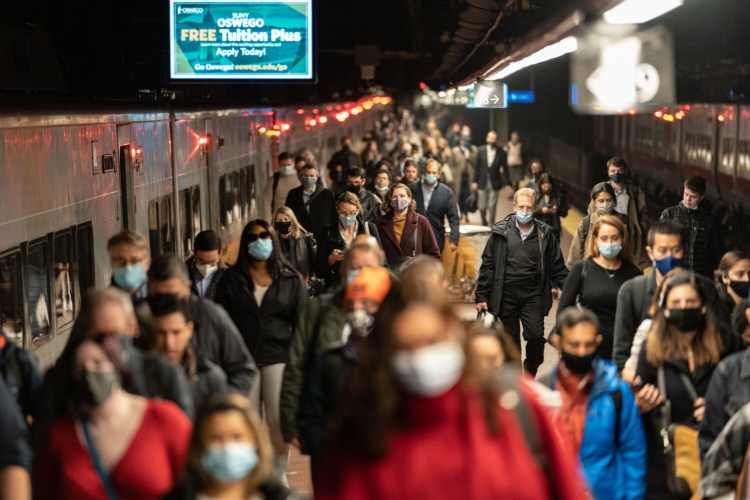With inflation flaring, American white-collar employees have an edge in year-end salary discussions, though it may prove tough to secure raises that outpace surging prices.
The insatiable demand for labor in the pandemic recovery – coupled with record quits rates and a barely changing supply – has fueled wage increases this year, particularly for lower-paid jobs in sectors like hospitality and retail.
Salaries of office staff and higher-income employees haven’t kept up with the growth. But the recent spike in consumer prices now gives these workers more ammunition to negotiate higher pay.
“The increase in cost of living is a feather in the cap for job seekers in negotiating pay with employers,” said Rich Deosingh, a district president for staffing agency Robert Half International Inc. “If you look at positions in bigger cities, such as New York or the Bay Area, wages need to be in-line or above where the cost of living trends are going.”
A University of Michigan survey shows that 1 in 5 Americans expects a raise of at least 10% in the coming year. Whether they’ll get what they want, and whether that’ll be enough to keep up with inflation that is running at the faster pace in 30 years remains to be seen. Either way, pay raises for skilled workers add to inflationary pressures.
Managers don’t want to give in to every demand, but the risk of valuable staff leaving has led many to acquiesce with pay bumps.
Like all human-resources managers right now, Andrea Mullens says one of her biggest concerns is holding onto her staff. She’s taken to adjusting compensation preemptively for some employees to keep them from entertaining offers elsewhere.
“It’s crazy,” said Mullens, who’s vice president of human resources at the cloud-computing division of IT manufacturer Ingram Micro. “The market is inflating, we’ve really seen it.”
One counteroffer that’s become common in her industry is a 20% bump in salary plus a one-time cash bonus to bridge the gap to what a rival firm is dangling. Another way to hold onto employees is accelerated promotions into leadership, which can deliver about a 35% increase in cash compensation.
Mullens, who oversees a 2,000-person white-collar workforce that’s slated to grow “substantially” in the next three years, said that despite her best efforts, she’s seen employee turnover creep up through 2021.
Workforce consultants are now encouraging companies to conduct more so-called “stay” interviews, where managers try to learn more about what motivates employees and what would keep them happy. Despite all the focus on work-life balance and flexible arrangements, that often comes down to money, according to a survey of more than 5,000 employees conducted by McKinsey earlier this year.
Nearly half of all workers got a raise in the past year or switched jobs for better pay, with those who have secondary degrees and make more than $75,000 annually being the most likely to get a bump, according to a Bankrate survey.
Workers who changed jobs in September saw their wages increase a record 6.6% since last year, according to payroll processor ADP, double the wage growth seen by the overall U.S. workforce in the third quarter.
“Base wages are moving up very rapidly,” said Scott Hamilton, who runs the compensation and human resources practice at Gallagher, a consulting and insurance firm.
The company ran a survey earlier this year showing pay would increase a median 3% in 2022, though he says that’s already a conservative estimate now. “The cost of labor and the scarcity of labor have come together to create a perfect storm,” he said.
Average hourly earnings rose 4.9% in October from the prior year, higher than the pre-pandemic rate. But the pay boost was still not enough to keep up with inflation running at 6.2% last month.
With the U.S. entering the tightest labor market conditions since the 1950s, wage pressures will take over as the dominant driver of price increases in the second half of next year, Aneta Markowska, chief financial economist at Jefferies Group LLC, wrote in a report this week.
Not everyone will get a big bump. Many might have to settle for a 2% to 3% pay increase next year, according to Gartner’s head of human-resources research Brian Kropp, as those 15% to 20% pay-boost counteroffers their peers receive will eat up a lot of the compensation budget.
“In this environment, those that are getting ahead are either changing jobs or asking their employer for a counteroffer – and usually getting it,” he said.
Send questions/comments to the editors.



Success. Please wait for the page to reload. If the page does not reload within 5 seconds, please refresh the page.
Enter your email and password to access comments.
Hi, to comment on stories you must . This profile is in addition to your subscription and website login.
Already have a commenting profile? .
Invalid username/password.
Please check your email to confirm and complete your registration.
Only subscribers are eligible to post comments. Please subscribe or login first for digital access. Here’s why.
Use the form below to reset your password. When you've submitted your account email, we will send an email with a reset code.